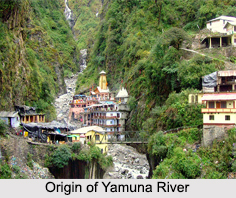 Known to be one of the largest tributary of the Ganga River in northern India, the Yamuna River has its origin in the Yamunotri Glacier of Uttarkashi in the state of Uttarakhand. The Yamunotri Glacier stands at an elevation of 6, 387 m on the south western slopes of Banderpooch massif of the Lower Himalayas.
Known to be one of the largest tributary of the Ganga River in northern India, the Yamuna River has its origin in the Yamunotri Glacier of Uttarkashi in the state of Uttarakhand. The Yamunotri Glacier stands at an elevation of 6, 387 m on the south western slopes of Banderpooch massif of the Lower Himalayas.
The river flows in a southwardly fashion through the Himalayan foothills and the Shivalik Hills, exiting Uttarakhand and flows onto the Indo- Gangetic Plain along the borders between the states of Uttar Pradesh and Haryana to the west. The river then passes through Delhi, where it feeds the Agra Canal. The Yamuna River flows through Mathura, Agra, Firozabad and Etawah, where it receives a number of southern tributaries, the largest of which are the Chambal, Sindh, Betwa and Ken rivers.
The Yamuna also flows through Allahabad for a course of about 1, 376 km and joins the Ganga River. The confluence of these 2 rivers is considered to be extremely sacred and is the site of annual festivals along with the Kumbh Mela, which is held every 12 years and is attended by millions of devotees.
The origin of Yamuna River- Yamunotri, is considered to be a sacred place because of the Yamunotri temple, dedicated to Goddess Yamuna which is one of the holiest shrines in Hinduism and part of the Chota Char Dham pilgrimage journey.
This article is a stub. You can enrich by adding more information to it. Send your Write Up to content@indianetzone.com















